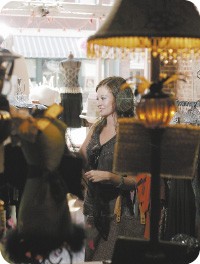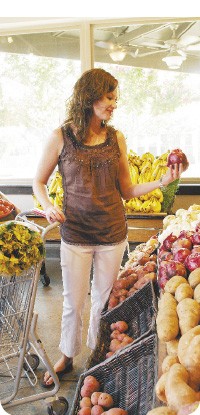It’s no secret how singular an experience a visit to downtown Memphis is. Whether they’re from Tokyo, Kennett, Missouri, or Midtown Memphis, people are drawn to the history, unique venues, atmosphere, and promise of an  Justin Fox Burks
Justin Fox Burks
unforgettable experience that downtown has to offer. Be it navigating the human rapids of Beale on a Saturday night or divining the human experience at an art exhibit on South Main, downtown is your one-stop shop for whatever it is you desire.
Similarly, downtown is the destination for foodies worldwide. Downtown Memphis is the culinary crossroads of the professors of the indigenous — Cozy Corner on North Parkway and Gus’s Fried Chicken on South Front — and the masters of the traditional — Chez Philippe in the Peabody and Texas de Brazil on South Second.
But everybody knows that. If it’s a secret, it’s poorly kept.
What aren’t very well known are the amenities of everyday life that downtown has to offer. There are many preconceived notions about the status of downtown as a residential community, primarily the conception that there is a difficulty of access to the staples of ordinary existence. Justin Fox Burks
Justin Fox Burks
Downtown resident Carrie O’Guin shops at Muse on South Main.
But when it comes to schools and child-care, groceries (see page 11), health-care, and other necessities, however, these assumptions are proven to be unfounded. In fact, no matter what it is you’re looking for as a resident, downtown has it; whatever your need, downtown can provide a solution. It’s no secret to Darnell Gooch, a City Commons resident who also works downtown. Gooch says, “Most of my stuff is around here. … I don’t go too far from downtown.”
From head to toe, body to soul, for every member of the family, you can bet it can be had downtown. Downtown’s answer is like a paraphrase of Marlon Brando’s line from The Wild One: Whaddya need?
Need health-care? At the integrated medical clinic and wellness center Harbor of Health in Harbor Town, Monday through Saturday you can see a general practitioner who accepts insurance and sees patients (even without an appointment) or take classes such as cardio/strength, Pilates, yoga, and kickboxing. If needed, a recommendation to a specialist can be easily made.  Justin Fox Burks
Justin Fox Burks
Borrow a book from the Cossitt Branch Public Library.
A membership at the wellness center includes a personal care manager who helps create goals and provides encouragement for your improving health.
Full eye services are available at Memphis Family Vision Practice’s SEE Main Street location on South Main. They offer complete vision care, and you can look stylish and smart after choosing your glasses from over 600 frames at their optical boutique. And at the Downtown Dentist on North Front, your smile can sparkle as bright as a classic sunset reflecting off the Mississippi.
For more pressing health-care needs, the Medical District is at the eastern edge of downtown, with the sprawling Methodist Healthcare system and Le Bonheur Children’s Medical Center. There are also numerous attendant general practitioners and specialists located in the Medical District.
As the saying goes, an ounce of prevention is worth a pound of cure, and if you’re looking to convert your pounds into ounces, downtown has many fitness options available. Harbor Town resident Renee Quillin prefers to exercise at the many public sites where you can walk, jog, bike, or roll — such as the Mud Island Greenbelt Walkway and Tom Lee Park. There are also a number of private fitness centers. Among the best is the Fogelman Downtown YMCA on Madison, which has an indoor swimming pool, fitness classes, nautilus machines and free weights, and racquetball courts.  Justin Fox Burks
Justin Fox Burks
Grab your joe and go or stick around and relax at the Daily Grind Coffee Bar.
Downtown resident Jennifer Rayburn frequents the Y and takes aerobics classes there. She says, “It’s cheap for students too: They give a discount there.” For the medical-school student at UT-Memphis, it’s a valuable add-on that makes it that much more convenient to her downtown lifestyle.
WellWorX Sporting Club on North Main and Curves for Women on Monroe are other popular fitness destinations for downtown residents, while at the Peabody Athletic Club in the famous hotel, you can work out amid and be inspired by stunning visuals, such as the heated indoor pool, which is surrounded by marble, mosaics, and Greek columns.
All this exercise will have you feeling good about downtown. You can look even better with a trip to the numerous spas, hair salons, and tanning salons. At Gould’s in the Peabody and Harbor Town Day Spa, traditional therapies such as massage and aromatherapy will allow you to unwind after a stressful day on the job, while at H2Oasis, water treatment provides the same kind of relief. You also won’t have to leave downtown for your haircut, no matter how basic or how elaborate. CityHouse Salon and Silver Salon on G.E. Patterson and Rand’s Harbor Town Salon can give you locks that will make you the envy of your Midtown counterparts.
One concern expressed most often about downtown is that, without a mall on the scale of Wolfchase or the Avenue Carriage Crossing in Collierville, there must be a dearth of clothes-shopping options. David Clemons, a resident in the City Commons at South End condo complex, sees things differently.  Justin Fox Burks
Justin Fox Burks
He does a lot of his shopping at Shelton’s Clothiers on South Main and New York Suit Exchange on Union. Also available with many men’s clothing options are American Apparel on the corner of South Main and G.E. Patterson, Lansky 126 in the Peabody hotel, and the national chain GAP in Peabody Place. And while men have it good, women may have it even better: Muse on South Main, Raiding the Closet on Union, and Ann Taylor Loft, Victoria’s Secret, and Coco & Lilly in Peabody Place. Riverset resident Jennifer Rayburn likes the excellent fashions and convenient location of Blu Champagne in Harbor Town.
Among the main considerations for people moving downtown is the availability of day-care and education. As is the case in other regards, downtown once again excels. Several of the best day-cares in Shelby County are located downtown, with Calvary Place Child Care on North Second and Bluff City Academy Daycare on North Main. In Harbor Town, educators at the Foreign Language Immersion Childcare Center take an original tack with their infant-to-pre-kindergarten charges, teaching them Spanish so that, by the time the children leave the program, they can understand and speak the language. There are also a few downtown elementary schools, including Downtown Elementary Optional School, which provides K-6 education and also makes available extended child-care for working parents. St. Patrick’s School on South Fourth is a Catholic elementary school under the Memphis diocese.
Your four-legged “children” can be well taken care of too. The Downtown Animal Hospital on North Third handles pet emergencies and regular check-ups, shots, and other care. Mr. Scruff’s Pet Service provides services that range from daily dog walking to pet sitting.
While downtown may be the public-entertainment mecca of the Mid-South, the area also provides plenty of options for those wishing to relax at home. One suggestion: Curl up with a good book and a bottle of wine. You can now buy books downtown at the just opened — and appropriately named — Downtown Books at 152 Madison. And though it’s no longer the Romanesque red-sandstone vision that it once was, the Cossitt Branch Public Library, the first public library in Memphis, is still up and running and ready to serve downtown residents’ needs.  Justin Fox Burks
Justin Fox Burks
Gestures has flowers, gifts, and even a daily ‘happy hour.’
As part of the Memphis Public Library system, even if Cossitt doesn’t have it, you can get overnight delivery of most materials from other branches. With a book in hand, you’re ready for some spirits, and downtown has many options, including the Corkscrew on South Front, Wine and Spirits on Auction in Uptown, and Frank’s Liquor on South Main. If your tastes run to the cinematic, check out the Movie and Pizza Co. at Harbor Town, where, among other things, you can compare and contrast the portrayals of iconic downtown bar Earnestine & Hazel’s in 21 Grams and Elizabethtown.
What else do ya need? A florist or last-minute gift ideas? You can’t do much better than Gestures, Sharp’s Flowers, or Ritzee Florist, all on South Main. Need to ship something? Try the UPS Store on South Second. Or do as Darnell Gooch suggests and use the post office, which for the City Commons resident, is just “around the corner.” Need some toiletries or odds and ends? There’s a Family Dollar on Main near Monroe and a Walgreens on Main near Madison. Go to Gator Print on Monroe if you need to do some photocopying. Coffee? Start your day off right or recharge later with the java offerings at the Daily Grind or Empire Coffee on North Main or Bluff City Coffee on South Main.
You can’t throw a rock downtown and not hit a barbecue joint, a bank, or a church (so your stomach, wallet, and soul are all covered). You can also put up visiting guests in any of the numerous hotels. They’ll be much closer to you and the places they’ll want to visit while they’re in the Bluff City. Justin Fox Burks
Justin Fox Burks
The Main Street Trolley is a great way to navigate downtown.
Dry cleaner? There are many downtown: Kraus Model Cleaners on Auction, Happy Day Laundry and Cleaners in multiple locations downtown, and CityHouse Café Cleaners on G.E. Patterson (see page 9).
Downtown Memphis is a great place to visit. And it’s a better place to stay. It may not be widely known, but the secret is spreading. As Deborah Smith, a downtown resident and owner of CityHouse Café Cleaners, says about the gospel of downtown, “You hear all the wonderful news. One thing about positive news is that you can’t help but be positive when you hear it.”
Loose lips may sink ships, but they also can save cities. Pass it on. ●
And Speaking of Groceries …
One of the biggest concerns of prospective residents downtown is the status of grocery stores in the area.
The concerns are mirrored in current downtown residents. Darnell Gooch, a resident at City Commons condos, says, “I think we need a grocery store down here.” Gooch currently travels to the Midtown Schnucks on Union on a regular basis. Gooch has gone to the Memphis Farmers Market on Saturdays for some fruit and vegetables, but he feels it doesn’t compare to a Wal-Mart.
Downtown resident Deborah Smith agrees. She gets many staples, such as bread, milk, and eggs, at the South Main  Justin Fox Burks
Justin Fox Burks
Happy Day Laundry provides service that’ll leave you with a smile.
Market, but she sometimes drives to the West Memphis Wal-Mart for more involved shopping.
For Kelly Kiernozek, manager at Miss Cordelia’s Grocery in Harbor Town, the task is clear: Get the word out about her business. “So many people think of this as a convenience store,” Kiernozek says. “[But] you can get every single thing you need at Miss Cordelia’s.”
Riverset resident Jennifer Rayburn agrees: “I’m probably [at Miss Cordelia’s] three or four times a week. They have pretty much everything I need.”
In fact, Miss Cordelia’s has most of the items that larger grocery stores carry, from laundry detergent to locally produced foods, from soup to nuts. For parents, there’s diapers and baby food. For pet owners, pet food. Cereals range from the health-conscious to Saturday-morning-cartoon fare. And they have a large produce deparment, a meat counter, and a deli.
There’s also beer, and lots of it. Miss Cordelia’s has over 100 beers, and they special-order beer — or any grocery item — that customers request. Customer service is paramount. Kiernozek says, “If someone wants to know how something [tastes], we’ll open it.”
Miss Cordelia’s isn’t the only place for groceries downtown. At the Easy Way Food Store on North Main, fine produce can be had, and at Dixie Meat on Jefferson, the selection is a cut above. Though they primarily cater to commercial and wholesale buyers, Dixie Meat does not neglect downtown residents. Just call in advance so they can verify availability. (Go to www.dixiemeat.com for more information.)
At South Main Market on G.E. Patterson you can also find the essentials, and every Saturday, on G.E. Patterson, the Memphis Farmers Market is held, with locally produced fruits and vegetables, pastries, breads, flowers, and sundry seasonal items.
The secret about downtown groceries does seems to be increasingly well-known: “It’s grown leaps and bounds, and every day we try to bring in new items or try to cater to the neighborhood with the new people coming in,” Kiernozek says.
As more people discover the grocery options downtown offers, the area’s best-kept secret could become one of its best-known benefits. ● — GA
Coming Clean
For Deborah Smith, the owner of CityHouse Café Cleaners (formerly CityHouse Dry Cleaners — the name change takes effect September 1st), business is booming. It’s a sign of great things downtown. The business has “quintupled” since opening “because people are moving into the condos quickly,” Smith says. Plans are in the works for several more Café Cleaners across downtown, the next to be at 99 North Main on September 1st.
The secret to her success: service. Smith “always asks [her] customers, ‘What are you looking for downtown that you don’t have?'” Café Cleaners has partnered with Starbucks, providing complimentary coffee, hot chocolate, Tazo Tea, and other products. “I’m always looking to see what can be done downtown.
“I’m loving the growth, I’m loving the vibe, how everything is like wow! It’s revitalized, because when I came, none of this was here, in 2004. I saw the possibilities before the cleaners was even here.”
Smith has a lot invested in downtown beyond business. She’s also a resident. She prides herself on the downtown way of life. “It’s a friendly-based downtown. It’s like living out in the suburbs, but we’re downtown.”
Smith has experience in urban environments in the process of renewal. Smith says, “I’m originally from New York. When I came here in 2004, downtown Main Street reminded me so much of Soho, Greenwich Village. I saw the change  Justin Fox Burks
Justin Fox Burks
Miss Cordelia’s Grocery in Harbor Town has a wide selection of produce, a meat counter, and a deli.
[there]. I remember when everything started changing, rebuilding, and revitalizing in New York City.” Smith later lived in downtown Orlando and makes comparisons between New York, Orlando, and Memphis. “The downtown areas were like most cities — industrial, trains, warehouses — and everything just kept converting to condos. … I’ve seen it for the last 15 years, so to come here … you can really see what’s going on. It’s just like any other major city. I could easily compare Memphis to Atlanta now.”
For Smith, the improvement of downtown can happen in the little touches her business offers: alterations, wash/dry/fold service, free collar stays, free lint brushes, free cufflinks, and button replacement, with plans for a same-day shoeshine service in the works.
Smith’s philosophy is simple: “I’m a neighborhood dry cleaners.” ● — GA
 Justin Fox Burks
Justin Fox Burks  Justin Fox Burks
Justin Fox Burks  Justin Fox Burks
Justin Fox Burks  Justin Fox Burks
Justin Fox Burks  Justin Fox Burks
Justin Fox Burks  Justin Fox Burks
Justin Fox Burks  Justin Fox Burks
Justin Fox Burks  Justin Fox Burks
Justin Fox Burks  Justin Fox Burks
Justin Fox Burks  Greg Cravens
Greg Cravens